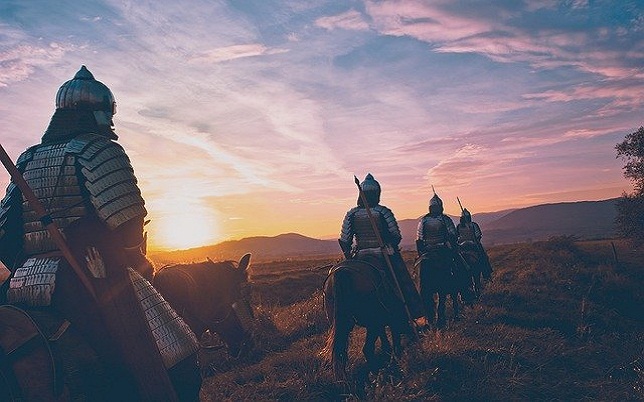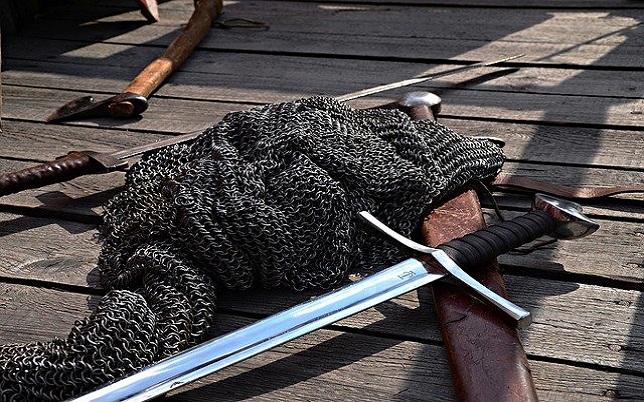The Muslim sovereigns of India were chiefly Turks, Afghans or Mongols (Mughals) whose administrative policies were based partly on the Shariah and partly on their own customary usages. Similarly, in the case of their military organisation, most of them followed the decimal system of the division of armed forces introduced by Chingiz Khan. Officers were appointed, according to this system, over the units consisting of 10, 100 and 1000 troops.
The officers commanding one thousand men were known as Umra-i-Hazara, those over a hundred men as Umra-i-Sadah and so on. Paik was the name given to the ordinary soldier or footman.
An officer known as Arzul-Mamalik or the officer-commanding made an annual inspection of the equipment and arms of his troops. Similar inspections were rigorously carried on before sending the troops on a battle-front.
Contents
Military Reforms by Alauddin Khilji
Alauddin Khilji (1296-1316) was the first ruler to reorganise the armed forces and to fix annual salary of the soldiers of different grades: first grade got 234 tankas, second grade 156 tankas and third grade 78 tankas.1( Tanka, weighing one Tola, was both of silver and gold)
Military Reforms by Sher Shah Suri
Sher Shah Suri (1538-45) gave his whole-hearted attention to the overhauling of the military administration. The system of branding the horse of the contingents and a roster in which the name, personal features, height, age and address of each cavalryman were recorded, were introduced.
The purpose was to prevent the assignees from producing borrowed infantry and cavalry at the time of periodical muster-parades before Arz-ul-Mamalik. He stationed the troops at different strategic points and ordered them to build a mud-fort wherever they camped. Sher Shah gave following major instructions to his army:
- Sher Shah Suri forbade his troops to destroy the sown crops during the march of the forces, punished them if any such case was brought to his notice and paid compensation for the loss incurred on this account.
- Similarly, compensation was also paid for the destruction of crops or groves by the elephants drafted for the imperial forces.
- Sher Shah also forbade to arrest any non-combatant during the war.
Military Reforms by Salim Shah
Jalal Khan, son of Sher Shah Suri ascended the throne in 1545, after his father’s death, and assumed the title of Islam Shah, but he was commonly known as Salim Shah 2. Salim Shah (1545-54) remodelled the army further. He divided the armed forces into two broad categories, viz. small and big contingents. The smaller ones were further subdivided into troops and squadrons of 50, 200, 250 and 500 each while the bigger divisions consisted of 5,000, 10,000 and 20,000.
He also ordered that each squadron of 50 cavalry should include two scribes, one knowing Persian and the other Hindustani language.
For the administration of justice, Salim Shah made it incumbent to appoint two judicial officers, one of whom was to be an Afghan and the other a Hindu.
Salim Shah increased the number of military cantonments, extending them from Sonargaon in Bengal to Kabul.
Military Reforms by Akbar
During the reign of Akbar (1556-1605), nine more regulations were made for making further improvements in the organisation of armed forces.
1. In 1573, the eighteenth year of his reign, Akbar re-established the practice of the branding and verification of horses.3
2. Mansabs or ranks were allocated to officers of the State, military or civil, beginning from Dah-Bashi (Commander of the ten) to Panj-hazari (commander of five thousand).4
Towards the end of Akbar’s reign a few men were promoted to the rank of Haft Hazari (commander of seven thousand) which was the highest that a person not belonging to royal family could attain.
The mansabs of the princes ranged from 7,000 to 10,000 during Akbar’s reign.
The number and ranks of the mansabs were later on increased during the reign of Shahjahan and Aurangzeb.5
3. A separate rank of gentleman troopers, called Ahadis or Yakka-sawars, was constituted. These troopers were placed under the personal command of the Emperor.6
4. The cavalrymen were allowed to keep two or three horses. They were known Sawar-do-aspa or Sawar-seh-aspa.7
5. The horses were divided into different classes. These were Arab horses, Mujannas, Turki horses, Yabus, Tazis, Jangla, etc.8
Abul Fadl has added one more class of Persian horses but he also says that these resembled Mujannas horses.
6. The elephants of the army were also divided into five classes. 9 The category was later on increased to seven.
7. Infantrymen were classified into three categories, viz.
Iranians and Turanians
Hindustanis
Khalsa
8. Salary was fixed for different categories of the imperial troops.
An Irani or a Turani trooper got 25 rupiahs per month, an Indian got 20 rupiahs and Khalsa 15 rupiahs.
Similarly, if a cavalryman had an Iraqi horse, he got 30 rupiahs; if Mujannas, 25 rupiahs, if Turki, 20 rupiahs; if Yabu, 18 rupiahs; if Arabi 15 rupiahs; and if a Jangla, 12 rupiahs.
Another class of infantrymen, divided into three classes, got 15, 10 and 8 rupiahs respectively.
The Matchlock-bearers had also a fixed pay of 7 rupiahs 12 annas, 7 rupiahs and 6 rupiahs 12 annas per month according to the grades they held.
9. Half of the expenditure on animals in the use of army was met from Bait-ul-Mal.
Strength of the Army of Muslim Rulers of India

According to Firishta the army of Sultan Alauddin Khilji consisted of 4,75,000 well-equipped and accoutred horsemen.10
But, during the reign of Firoz Shah the number of cavalry consisted of 80,000to 90,000 only. Siraj Afif, however, mentions the strength of the force as 80,000 only.11 Infantrymen and the force consisting of slaves were in addition to it.
Sher Shah Suri had 1,50,000 cavalry, 25,000 infantry and 5,000 elephants.
During the reign of Shahjahan the armed forces consisted of 1,00,000 cavalry, 80,000 officers and 7,000 Ahadis, some of whom were horsemen and match-lockers. Another force of 30,000 men including matchlock-bearers, heavy and light artillerymen, was in addition to these.
The princes and grandees had an additional force of 1,85,000 cavalry under their command which excluded the forces allowed to be maintained by the Faujdars and Karoris for the administration of the parganas. The emperor’s personal contingent, which always accompanied him in the capital and on excursions outside, numbered 35,000 cavalry and 10,000 infantrymen.
The estimated strength of Moghul Army given by William Irvine in The Army of the Indian Moghuls is as follows:
Period | Cavalry | Matchlockers & Infantrymen | Artillery | Authority |
Akbar | 12000 | 12000 | 1000 | Blochmann, p.256 |
-do-* | 384758 | 3877557 | ||
Shahjahan | 200000 | 40000 | Badshahnama, II p.715 & Blochmann, p.254 | |
Aurangzeb | 240000 | 15000 | Bernier | |
-do-* | 300000 | 600000 | Catron | |
Mohd. Shah | 200000 | 800000 | Tarikh-i-Hind of Rustam Ali |
* Maintained by retainers, throughout the provinces.
Abul Fadl however says that Zamindars of the country furnished, during the reign of Akbar, four million four-hundred thousand men. 12
Artillery Power of Muslim Rulers of India
These were of two kinds- The first of these consisted of 50 or 60 pieces of heavy artillery mostly of brass, which followed the emperor. These were taken on carts by the infantrymen. Each piece of artillery was attended by a Gol-andaz (cannon-man) and a horse also accompanied each gun.
One of these heavy brass guns was taken on a dais decorated with red flags and it accompanied the Emperor wherever he went.
There were other brass or iron pieces of heavy artillery, so ponderous, that twenty yoke of oxen were necessary to draw them along.
Naval Force of Muslim Rulers of India
The naval force of Shahjahan consisted of one thousand watercrafts each of which had 70 to 80 seamen, matchlock-bearers, artillerymen, archers, rocket men, swordsmen, drum-beaters, iron-smiths, wood-workers, etc. in all, the total naval force consisted of 70,000 men. This fleet was stationed in the Gulf of Bengal and paid out of imperial revenues realised from that suba.
Order of Battle of Muslim Rulers
The ranging of the army in order of battle was normally made in this manner. The heavy artillery was fixed on an elevated ground connected together by chains to prevent the horsemen of the other side from riding through the lines and cutting down the gunners.
Behind the guns, zamburaks or long swivels resembling astrolabe with one or two pound balls fastened upon the saddle of camels were stationed.
The camel rider fired on the enemy ranks with these guns. The gun revolved on a swivel fixed on the pommel of the saddle, and the bombardier, sitting astride behind it, loaded and fired with wonderful quickness.
Thereafter, matchlock-bearers were arrayed and last of all were the rows of horsemen.
The army ranged on the battle front was divided into three parts, viz. Maimanah (left-wing), Mayassarah (rightwing) and Qalb (the centre), also known as Jaranfar (Jaranghar), Baranfar (Baranghar) and Qaul.
All the three parts consisted of the bravest soldiers, the emperor himself being present in the centre on an elephant. A red canopy was fixed with the saddle of the emperor’s elephant. An advance party of scouts was stationed in front of these three divisions.
Conduct of Battle of Muslim Rulers
As the hostilities began, the artillery duel went on along with the fire by matchlock-bearers and zamburaks. The archers were also ordered to take the aim at the enemy troops. While this duel went on, each side tried to break the barrier of chains to engage the enemy in hand to hand fight.
Mansabdars or Fleet Commanders during Muslim Rule
As already stated the Moghuls had introduced mansabs or ranks ranging from Dah-bashi to Panch-hazari for the nobles and grandees. During the reign of Akbar the princes were conferred the rank of Dah-Hazari. However mansabs up to Neh-Hazari were granted to the grandees by Shahjahan and his successors, while those allowed to the princes went up to 60,000.
The number of each class of mansabdars was fixed which could decrease owing to the death of any mansabdar but was never increased. It was incumbent on each mansabdar to maintain a fixed establishment of horses, elephants, camels, beasts of burden and carts commensurate with the dignity of his rank.
Here we give a table of the establishment of principal mansabs. The table gives only principal mansabs by way of illustration and leaves out many intervening ranks, the total number of which was 66. The numbers in bracket represent the total number of men under the command of mansabdar.
Mansab (Post) | Horses | Camels | Mules | Elephants | Carts | Monthly Salary |
Deh Hazari (10000) | 680 | 160 | 40 | 200 | 320 | 60000 |
Hasht Hazari (8000) | 540 | 130 | 34 | 170 | 260 | 50000 |
Haft Hazari (7000) | 490 | 110 | 27 | 140 | 220 | 45000 |
Panj Hazari (5000) | 340 | 80 | 20 | 100 | 160 | 30000 |
Chahar Hazari (4000) | 270 | 65 | 17 | 80 | 130 | 22000 |
Seh Hazari (3000) | 200 | 50 | 14 | 70 | 100 | 17000 |
Do Hazari (2000) | 150 | 30 | 7 | 40 | 60 | 12000 |
Hazari (1000) | 104 | 21 | 4 | 30 | 42 | 8200 |
Neh Sadi (900) | 100 | 20 | 4 | 30 | 40 | 7700 |
Hasht Sadi (800) | 82 | 20 | 5 | 28 | 34 | 5000 |
Haft Sadi (700) | 58 | 17 | 3 | 19 | 27 | 4000 |
Shash Sadi (600) | 38 | 14 | 2 | 15 | 21 | 3500 |
Pan Sadi (500) | 34 | 13 | 2 | 11 | 15 | 2800 |
Chahar Sadi (400) | 20 | 5 | – | 10 | 12 | 2000 |
Seh Sadi (300) | 15 | 4 | – | 7 | 11 | 1450 |
Do Sadi (200) | 13 | 3 | – | 5 | 7 | 975 |
Yuz Bashi (100) | 10 | 2 | – | 3 | 5 | 700 |
Panjahi (50) | 8 | 1 | – | 2 | 2 | 250 |
Basti (20) | 5 | – | – | 1 | – | 135 |
Dah Basti (10) | 4 | – | – | – | – | 100 |
References:
- Administration of the Delhi Sultanate, pp. 234/35 and Firishta Vol. I, p. 389
- Firishta, Vol. II, p.273
- Ain-i-Akbari (Blochmann), p. 265/66
- Ain-i-Akbari (Blochmann), p. 249
- The Army of the Indian Moghuls, p. 4
- Ain-i-Akbari (Blochmann), pp. 259-60
- Ibid, p. 261
- Ibid, p. 243
- Ain-i-Akbari (Blochmann), p. 246
- Firishta, Vol. I, p. 389
- Siraj Afif, p. 209
- Ain-i-Akbari (Blochmann, p. 241)

